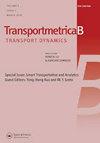基于不同跟车状态的窄车道车辆行驶特性研究
IF 3.4
2区 工程技术
Q2 TRANSPORTATION
引用次数: 1
摘要
本文章由计算机程序翻译,如有差异,请以英文原文为准。
Research on vehicle driving characteristics in narrow lanes based on different vehicle-following states
Drivers could be more careful when vehicles move in the non-standard narrow lane. This might cause the drivers to behave differently from other normal-size lanes. To investigate the characteristics of the traffic flow in narrow lanes, this paper collected the vehicle trajectory data on four-lane road segments with 2.8m width and 3.25m width respectively. Firstly, the spatial distribution of wheel tracks in the lane under low traffic volume is studied, and the results show that the wheel trails’ distribution is obviously affected by three factors: speed, lane width, and lane in cross-section position, which are significantly different from normal-size lanes. Secondly, statistical analysis shows that vehicle-following status in narrow lane environment can be divided into three types: staggered following, parallel following, and transitional following. Finally, a multivariate logistic regression model is constructed to predict the driver’s following strategy under different driving micro-environment parameters. The research results can support the fine management of lanes and help to improve the driving strategy of autonomous vehicles.
求助全文
通过发布文献求助,成功后即可免费获取论文全文。
去求助
来源期刊

Transportmetrica B-Transport Dynamics
TRANSPORTATION SCIENCE & TECHNOLOGY-
CiteScore
5.00
自引率
21.40%
发文量
53
期刊介绍:
Transportmetrica B is an international journal that aims to bring together contributions of advanced research in understanding and practical experience in handling the dynamic aspects of transport systems and behavior, and hence the sub-title is set as “Transport Dynamics”.
Transport dynamics can be considered from various scales and scopes ranging from dynamics in traffic flow, travel behavior (e.g. learning process), logistics, transport policy, to traffic control. Thus, the journal welcomes research papers that address transport dynamics from a broad perspective, ranging from theoretical studies to empirical analysis of transport systems or behavior based on actual data.
The scope of Transportmetrica B includes, but is not limited to, the following: dynamic traffic assignment, dynamic transit assignment, dynamic activity-based modeling, applications of system dynamics in transport planning, logistics planning and optimization, traffic flow analysis, dynamic programming in transport modeling and optimization, traffic control, land-use and transport dynamics, day-to-day learning process (model and behavioral studies), time-series analysis of transport data and demand, traffic emission modeling, time-dependent transport policy analysis, transportation network reliability and vulnerability, simulation of traffic system and travel behavior, longitudinal analysis of traveler behavior, etc.
 求助内容:
求助内容: 应助结果提醒方式:
应助结果提醒方式:


